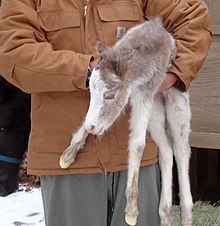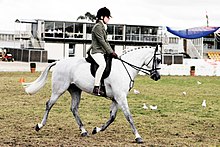Pony

A pony (also "poney") is a type of small horse (Equus ferus caballus). Depending on the context, a pony may be a horse that is under a given height at the withers, or a small horse with a specific conformation and temperament. Compared to a larger horse, a pony may have a thicker coat, mane and tail, with proportionally shorter legs, a wider barrel, heavier bone, a thicker neck and a shorter, broader head. The word pony derives from the old French poulenet, meaning foal, a young, immature horse.[1]: 1041
Small horses and ponies were traditionally used for
In modern use, some organizations may define a pony as a mature horse below a certain height at the withers; this may vary from about 142 cm (14.0 h) to nearly 150 cm (14.3 h).[citation needed] (Note: 14.3 hands means 14 hands and 3 inches, ie decimally 14.75 hands.) Some people classify an animal as either horse or pony from its pedigree and phenotype, no matter what its height.[citation needed] A full-sized horse may sometimes even be called a pony as a term of endearment.
Definition

For many forms of competition, the official definition of a pony is a horse that measures less than 14.2 hands (58 inches, 147 cm) at the withers. Standard horses are 14.2 or taller. The International Federation for Equestrian Sports defines the official cutoff point at 148 centimetres (58.3 in; 14.2 hands) without shoes and 149 centimetres (58.66 in; 14.2+1⁄2 hands) with shoes, though allows a margin for competition measurement of up to 150 centimetres (59.1 in; 14.3 hands) without shoes, or 151 centimetres (59.45 in; 14.3+1⁄2 hands) with shoes.[2] However, the term pony can be used in general (or affectionately) for any small horse, regardless of its actual size or breed. Furthermore, some horse breeds may have individuals who mature under that height but are still called horses and are allowed to compete as horses. In Australia, horses that measure from 14 to 15 hands (142 to 152 cm; 56 to 60 inches) are known as a "galloway", and ponies in Australia measure under 14 hands (56 inches, 142 cm).[3]
History

Ponies originally developed as a landrace adapted to a harsh natural environment, and were considered part of the "draft" subtype typical of Northern Europe. At one time, it was hypothesized that they may have descended from a wild "draft" subspecies of Equus ferus.[4] Studies of mitochondrial DNA (which is passed on though the female line) indicate that a large number of wild mares have contributed to modern domestic breeds;[5][6] in contrast, studies of y-DNA (passed down the male line) suggest that there was possibly just one single male ancestor of all domesticated breeds.[7] Domestication of the horse probably first occurred in the Eurasian steppes with horses of between 13 hands (52 inches, 132 cm) to over 14 hands (56 inches, 142 cm),[8] and as horse domestication spread, the male descendants of the original stallion went on to be bred with local wild mares.[7][8]
Domesticated ponies of all breeds originally developed mainly from the need for a working animal that could fulfill specific local draft and transportation needs while surviving in harsh environments. The usefulness of the pony was noted by farmers who observed that a pony could outperform a draft horse on small farms.[9]
By the 20th century, many pony breeds had Arabian and other blood added to make a more refined pony suitable for riding.[10]
Uses

In many parts of the world, ponies are used as
Characteristics

Ponies are often distinguished by their
Pony breeds have developed all over the world, particularly in cold and harsh climates where hardy, sturdy working animals were needed. They are remarkably strong for their size. Breeds such as the Connemara pony are recognized for their ability to carry a full-sized adult rider. Pound for pound ponies can pull and carry more weight than a horse.[12] Draft-type ponies are able to pull loads significantly greater than their own weight, with larger ponies capable of pulling loads comparable to those pulled by full-sized draft horses, and even very small ponies are able to pull as much as 450 percent of their own weight.[13]
Nearly all pony breeds are very hardy,
Ponies are generally considered intelligent and friendly, though sometimes they also are described as stubborn or cunning.[12] The differences of opinion often result from an individual pony's degree of proper training. Ponies trained by inexperienced individuals, or only ridden by beginners, can turn out to be spoiled because their riders typically lack the experience base to correct bad habits. Properly trained ponies are appropriate mounts for children who are learning to ride. Larger ponies can be ridden by adults, as ponies are usually strong for their size.[12]

For showing purposes, ponies are often grouped into small, medium, and large sizes. Small ponies are 12.2 hands (50 inches, 127 cm) and under, medium ponies are over 12.2 but no taller than 13.2 hands (54 inches, 137 cm), and large ponies are over 13.2 hands (54 inches, 137 cm) but no taller than 14.2 hands (58 inches, 147 cm).
The smallest equines are called
Similar or similarly named horses

Some horse breeds are not defined as ponies, even when they have some animals that measure under 14.2 hands (58 inches, 147 cm). This is usually due to body build, traditional uses and overall physiology. Breeds that are considered horses regardless of height include the Arabian horse, American Quarter Horse and the Morgan horse, all of which have individual members both over and under 14.2 hands (58 inches, 147 cm).
Many horse breeds have some pony characteristics, such as small size, a heavy coat, a thick mane or heavy bone, but are considered to be horses.
Some horses may be pony height due to environment more than genetics. For example, the Chincoteague pony, a feral horse that lives on Assateague Island off the coasts of Maryland and Virginia, often matures to the height of an average small horse when raised from a foal under domesticated conditions.[14]

Conversely, the term "pony" is occasionally used to describe horses of normal height. Horses used for
The term "pony" is also sometimes used to describe a full-sized horse in a humorous or affectionate sense.
The
See also
- Pony Express, mail delivery by horse-mounted couriers
- List of horse breeds, includes pony breeds
- Pony Club
- Equine nutrition
- Easy keeper
- Horse care
- Polish sport horse
- Norman Thelwell, the late British artist known for his cartoons of ponies and their riders
References
- ISBN 055010206X.
- ^ "PONY MEASUREMENT 2007 30 January 2007 " Explanation of Article 3103.1, FInternational Federation for Equestrian Sport Web site, Accessed October 7, 2009 Archived 26 July 2011 at the Wayback Machine
- ^ Owlet, Lorna and Phlip Mathews, Ponies in Australia, Milsons Point: 1979
- OCLC 39709067.
- PMID 12130666.
- PMID 11161199.
- ^ PMID 15034578. Archived from the original(PDF) on 17 November 2010.
- ^ ISBN 978-0-691-05887-0.
- ^ Smith, E. C. A. (November 1915). "The Pony Useful". In Bailey, Liberty Hyde; Saylor, Henry Hodgman (eds.). Country Life in America. Vol. 29. Doubleday, Page & Company. pp. 46–47 – via HathiTrust.
- OCLC 36179575.
- ^ Barakat, Christine. "Why Size Matters." Equus, October 2007, Issue 361, pp. 36-42
- ^ a b c d e f g "Pony Power!". January 2001.
- ^ McNeill, Erin. "Ponies at Boone County Fair pull their weight and then some" Missourian, July 27, 2010 Archived January 19, 2013, at archive.today
- ^ "Assateague National Seashore - Wild Horses". Archived from the original on 13 May 2010. Retrieved 10 May 2010.
- ^ Gantz, Tracy (2 May 2019). "The Track Pony: A Racehorse's Best Friend". The Horse.
Further reading
- Budiansky, Stephen. The Nature of Horses. Free Press, 1997. ISBN 0-684-82768-9
- Siegal, Mordecai (ed.). Book of Horses: A Complete Medical Reference Guide for Horses and Foals (by members of the faculty and staff, University of California, Davis, School of Veterinary Medicine). Harper Collins. 1996.
